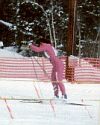CCSA US Nationals Wrapup
- On January 7th and 8th CCSA teams met at Soldier Hollow for their first official CCSA event of the year. While the primary event being contested was U.S. Nationals (and also Olympic trials!), the event actually served quadruple duty, as it was the Collegiate Cup (a nationwide collegiate race), a CCSA qualifier for NCAAs, and a RMISA (Rocky Mountain Intercollegiate Skiing Association—the western equivalent of CCSA) competition.
- Besides huge racing fields and numerous competitions being contested, this CCSA competition also had a different flavor than usual due to the small number of CSSA athletes competing. Given the elite level of competition, the expense of the trip, and the fact that many of the small private schools of the CCSA were on J-term (a one month “semester” where students take just one class that meets for three to four hours a day) and thus students could not negotiate missing so much school, many CCSA teams brought very small squads to the competition.
- The Collegiate Cup is good for CCSA schools. While far less prestigious than NCAA Championships, the nation’s very best ski teams and athletes are one hundred percent in attendance, so the event is a good chance to send a message to the entire country. The women of NMU and UAF did just that, taking first and second in the Collegiate Cup, defeating well-known Division I teams such as Denver University, Colorado University, University of New Mexico, etc. While the central men didn’t place as high on the list, they nevertheless put three teams in the top-ten with UAF fourth, NMU eighth, and MTU tenth. Yet CCSA success in the collegiate cup is bittersweet because it points out the challenge, or impossibility, CCSA faces within the NCAA system: NCAA Championships scores Nordic and alpine. While the Collegiate Cup clearly demonstrated the strength of CSSA Nordic skiers, they face the fact that, as a team, they will never be winners at NCAAs, as not a single CCSA school sponsors NCAA alpine skiing.
- The first CCSA race at U.S. Nationals, the individual start classic held on January 7th, turned out to be one that tested the coaches’ classic waxing skills more than the athlete’s fitness. While most coaches hope for the perfect dry snow, extra blue day that will allow every athlete an equal chance to race on par with every other, the U.S. Nationals classic race was anything but that. In the early morning, the classic tracks were rock hard icy rails, but by the time the last woman started in the afternoon, most teams had begun to use the warmest klister in their wax line. Adding to this, extremely large starting fields meant that the men’s race took over two half hours to start, making snow conditions entirely different for the first and last skiers. As St. Olaf coach Kevin Brochman explains: "With the large numbers of participants and the fact that the conditions out west can change rather abruptly, I think they should have started the athletes every 15 seconds. There needs to be a way to qualify people for nationals; there are just too many skiers grinding up the course. As for the waxing and the results- I have never seen the results of top competitors have such a range, also due to the changing conditions.”
- Scott Jerome at UAF also experienced the waxing frustrations when temperatures rose dramatically and quickly early in the women’s race, but was able to salvage the situation for his latest starter. “Johanna Turunen had good kick 30 minutes before her start in the women's 10 km, then had no kick during the race. We managed to adjust our wax for our latest starter, Pavla Havlova, who raced her way into the top ten overall (8th, 2nd collegian).”
- Despite these waxing challenges, five CCSA women skied into the top-ten of the collegiate field. Lindsey Weier led both the region and the country taking the Collegiate Cup win in 37:14, two seconds over UAF’s Pavla Havlova. Havlova, recruited to UAF on a running scholarship, finished 22nd in NCAA Division II XC Running Championships this fall, but now that she’s made her debut in CCSA Nordic, looks as if she could do as well or even better at NCAA Division I Skiing Championships! NMU redshirt Morgan Smyth took 4th among the collegians, a result that helped her to be named to World Junior Championships Team. UWGB skier Johanna Winters continued her stellar season with an 8th place. MTU’s Kristina Owen took home 10th place.
Lindsey Weier, 10K classical ()
- In the men’s classic race, UAF showed clear dominance over every other CCSA team, placing four athletes in the top-thirty: Marius Korthauer 11th, Erik Wickstrom 13th, Bart Dengel 27th, and Jonas Tetlie 30th. Bryan Cook led NMU by finishing 15th, while teammates Adriaan Ostrander and Bill Bowler were 35th and 36th.
- After a day of nearly impossible classic waxing, conditions for the skate race were not straightforward, but were considerably easier to manage. As UWGB’s Bryan Fish explains:
- "Glide waxing for skate events is typically easier than classic, but it can be a challenge to nail down great glide in variable snow. Sunday's 5/10km freestyle events were somewhat challenging to wax for due to the fresh cover of cold, slow snow over old, highly transformed snow. Waxes that ran well in the transformed snow didn't run well in the areas that contained less traffic and more fresh snow cover. We selected a wax combination that was a "happy medium" between the two extremes."
- For the men, UAF was again the CCSA team to beat, placing three athletes in the top-thirty, led again by Marius Korthauer who skied to 11th. Bryan Cook again led NMU; this time with a 10th place finish. On the individual front, Gustavus senior Erich Ziegler had a breakout day finishing 21st. Aaron Ditty (MTU) and Andrew Rishavy (Gustavus) both posted top-fifties in 38th and 46th respectively.

Erich Ziegler in the 10km Freestyle race ()
While MTU Head Coach Joe Haggenmiller reported a tough week for his team in general, Aaron Ditty’s performance was a bright spot:- "I was very pleased with Aaron Ditty's performances through out the week. To have each race in the top 100 (absent a crash in the sprint) for a skier who was unable to qualify to go to the Junior Nationals is an accomplishment and shows how hard he has been working since he got to college. We had some other guys who skied decent, but I'm confident that we have better days ahead overall for our group."
-
On the women’s side, UAF’s Johanna Turunen overcame the bad wax memories of the previous day to take the collegiate cup win by a one second margin over Kristina Trygstaad-Saari. Meanwhile, Pavla Havlova showed that her classic result wasn’t just good skis, as she captured third, less than 20 seconds out from Turunen. Freshmen teammate Julia Coulter also recorded a third strong result for the Nanooks finishing 8th (first for freshmen!) in the Collegiate Cup. NMU redshirt Lindsay Williams was 10th, Tami Kochen was 11th, and Lindsey Weier was 12th. UWGB’s Johanna Winters also just made it into the top-twenty cut, finishing 20th.
- While the waxing for the classic race was certainly a frustration and a disappointment for many, most coaches and athletes were able to chalk it up as a learning experience. As Gustavus coach Jed Friedrich explains,
- "Anytime the field is so large and the snow conditions change so rapidly, waxing for classic racing is going to be a challenge. In our case, it affected our women more than the men. When our women tested their skis 10-15 minutes prior to start, they were good. As soon as they started, it changed. After the race was over, we talked about what we can do differently if we are faced with those conditions in the future. Fortunately, our skiers are mature enough to learn from tough races without dwelling on them. I think that really showed in the way they skated on the following day. I was happy for our skiers to leave Soldier Hollow with a good race."
- Case in point was Chandra Daw’s skate race, where she finished 32nd and seventh among CCSA athletes earning valuable points towards NCAA Championships qualification.
- The formula that CCSA is using to determine the athletes who will qualify for NCAA Championships is a different and more complex one than has been used in the past. Because UAF chooses not to attend the CCSA St. Cloud qualifier, the field for this event is weakened and thus, in the past, athletes who perform well there have earned more points than they deserve. In order to fix this problem and relate athletes’ performances to the strength of the field, CCSA has adopted FIS scoring. Due to the complexity of the scoring method, results take longer to process than they used to. Point totals from the U.S. Nationals have now been tabulated and the following athletes are ranked in the top-10. At the end of the CCSA season, six men and eight women will be selected to attend NCAAs. (Only three per team allowed.)
-
- Men:
- Marius Korthauer UAF 126.51
- Bryan Cook NMU 140.22
- Erik Wickstrom UAF 199.97
- Jonas Tetlie UAF 254.04
- Bart Dengel UAF 246.36
- Tyson Flaharty UAF 292.16
- Aaron Ditty MTU 264.30
- Phil Violett NMU 307.81
- Chris Harvey MTU 338.19
- Bret Bedard NMU 323.61
- Women
- Pavla Havlova UAF 208.24
- Lindsey Weier NMU 215.24
- Johanna Turunen UAF 234.54
- Tami Kochen NMU 258.65
- Johanna Winters UWGB 272.94
- Kristina Owen MTU 298.56
- Elizabeth Habermann UAF 352.92
- Julia Coulter UAF 360.35
- Kelly Ahern NMU 384.12
- Laura Dewitt NMU 400.59

|
About the author... Corey Coogan reports on U.S. collegiate skiing throughout the season. Coogan has published an updated version of One Week in March: a manual for prospective Collegiate Nordic skiers. A devoted racer, she competes for Alpina/Madshus Racing and Finn Sisu ski shop. |


